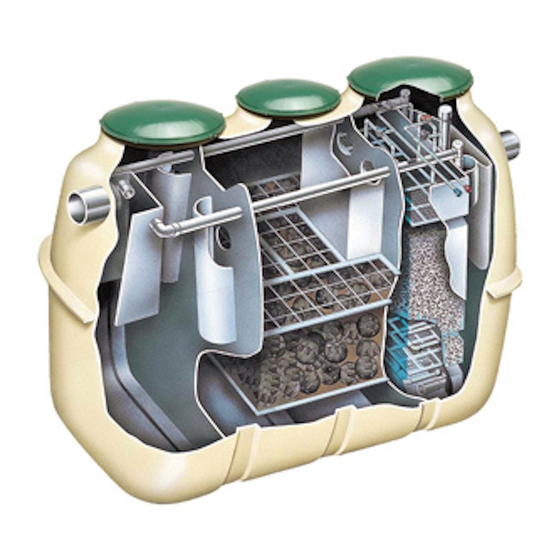Clarus Fusion Series Manuel du propriétaire - Page 14
Parcourez en ligne ou téléchargez le pdf Manuel du propriétaire pour {nom_de_la_catégorie} Clarus Fusion Series. Clarus Fusion Series 20 pages. Treatment systems
Également pour Clarus Fusion Series : Manuel du propriétaire (20 pages)

FUSION
1.
Scum – Very small amounts of scum may accumulate in
the corners on the outlet end of the system. This is normal.
Scum, should not be present elsewhere in the clean water
storage chamber unless the recirculation rate is too high or
daily flow exceeds the design capacity. If present, use ladle
to transfer to sedimentation chamber.
2.
Sludge – Test the sludge depth using the sampling device
included in the maintenance kit. The bottom section of the
sampler includes a check valve, which opens as the unit
is lowered into the liquid. When the sampler has reached
the bottom of the chamber and the liquid level equilibrated
at surface level, lift the sampler and this action will set the
check valve and retain the sample in the tubing. Withdraw
the sampler and note the depth of settled solids within the
sample. To release the material in the unit, touch the stem
extending from the bottom section against a hard surface
such as the partition wall in the sedimentation chamber. This
opens the check valve to drain the sample. Typically solids
are brown and well flocced.
Sludge Descriptions:
Black – septic or sewer-like odor due to hydrogen sulfide and
other gases
Brown – undigested sludge is light brown, becomes darker
with digestion, lightly settled
Clear – may see a clear water layer beneath solids if gas
carries solids upwards
Flocced - settled with texture similar to a tuft of wool
Grainy - gritty or sandy texture
Gray - partially digested sludge
Milky – light in color, cloudy, not transparent
Muddy – typically well settled, often present just after startup,
may be due to infiltration
Mustard - an off-color, remnants of digestion are often
yellowish in color
White - sometimes present after new construction often due to
drywall mud
PART B: Anaerobic Filtration Chamber
from the outlet baffle of the anaerobic filtration chamber to be
used for the following analyses:
1.
Transparency – A transparency reading more than 20 cm
is preferred.
2.
Scum – Should not be present unless recirculation rate is
too high or daily flow exceeds design capacity. To correct,
reduce the recirculation and or backwash rate.
3.
Sludge – A range of 0" to 25" (0 to 60 cm) is preferred.
Typically brown and settled, becomes gray to black as depth
and digestion increases.
PART C: Sedimentation Chambe
the outlet baffle of the sedimentation chamber for the following
analyses:
1. Scum – rising above the partition wall. If so, punch down
using ladle.
2. Sludge – A range of 0 - 50" (0 to 120 cm) is preferred.
Typically brown and settled, becomes gray or black as depth
and digestion increases.
OPERATION AND MAINTENANCE, continued
®
- collect samples
r – collect samples from
© Copyright 2014. All rights reserved.
OPTIONAL WATER QUALITY ANALYSES
PART D: Clean Water Storage Chamber
be collected as previously described.
1.
NO
N – Determined with the use of the nitrate test
-
3
strips included in the Fusion Maintenance Kit. Dip a
test strip into the water sample for 1 second, remove,
allow to react for 60 seconds, and read by comparing
to the color chart provided on the container. Nitrate-
nitrogen is the final step in the oxidation of ammonia.
The test strips provided range from 0-50 mg/L. No or
low nitrate concentrations are common in systems where
nitrifying microbes are absent. To correct high nitrate
concentrations in established systems increase the
recirculation rate.
2.
NH
N – Determined with the use of the ammonia test
-
3
strips included in the Fusion
test strip into the water sample and move up and down
for 30 seconds, remove, allow excess water to drain,
allow to react for 30 seconds, and read by comparing
to the color chart provided on the container. Ammonia-
nitrogen is measured using low range test strips, 0-6
mg/L. Low ammonia readings are desirable and require
no changes. To correct high ammonia readings decrease
the recirculation rate.
3.
Dissolved oxygen – Follow the instructions included
with the dissolved oxygen meter. D.O. should be
measured 25 inches (635 mm) below the water level.
4.
Temperature – Most dissolved oxygen meters include
a built-in thermometer which can be used to measure
temperature. Varies with system location.
PART E: Anaerobic Filtration Chamber
be collected and analyses performed as previously described
1.
pH – The range suitable for biological activity is 6.5 to 7.5.
Recurring results outside this range should be investigated –
water source for the home or business, chemical use, etc.
2.
NO
N – Adjustments should be based on water quality in
-
2
the clean water storage chamber.
3.
NO
N – Adjustments should be based on water quality in
-
3
the clean water storage chamber.
4.
NH
N – If this test is desired, it should be conducted
-
3
with test strips suitable for the expected concentration.
Adjustments should be based on water quality in the clean
water storage chamber.
5.
Dissolved oxygen
6.
Temperature – varies with system location.
PART F: Sedimentation Chamber
collected and analyses performed as previously described.
1.
pH – The range suitable for biological activity is 6.5 to 7.5.
Recurring results outside this range should be investigated –
water source for the home or business, chemical use, etc.
2.
NO
N – Adjustments should be based on water quality in
-
2
the clean water storage chamber.
14
– samples should
Maintenance Kit. Dip a
®
– samples should
- samples should be
